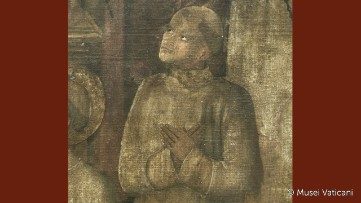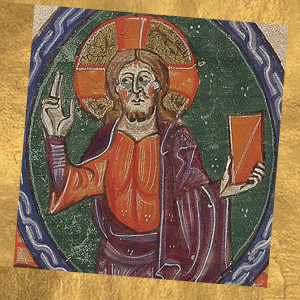St Peter Damian, Bishop of Ostia and Cardinal, Doctor of the Church, camaldolese

A difficult childhood
Born in Ravenna in 1007, he was the last of seven children. His mother felt she couldn’t cope with yet another child and refused to breastfeed him, effectively condemning him to certain death. A friend intervened, taking the child in her arms and scolding the mother who repented of her rash behavior and took care of him like the others. When she died, Peter was raised first by his sister Rodelinda and then by a brother who treated him and forced him to do the most menial tasks. Finally, he was entrusted to his eldest brother, Damiano, who was Archpriest in a parish near Ravenna and who took care of young Peter and his education. As a sign of gratitude, Peter added the name Damian to his own.
The vocation to monastic life
His first biographer, St John of Lodi, recounts two significant episodes of Peter Damian's youth. One day the boy found a coin: delighted, he thought he would buy a cake or a toy. Then, suddenly, he realized that anything he bought would give him only momentary joy, so he decided to take the money to a priest and have a Mass said for his deceased parents. On another occasion, when he was having lunch with a poor blind man, he chose the better quality white bread for himself, and offered the guest the darker bread. At that moment he felt like a bone had stuck in his throat. He repented of his selfishness and the moment he exchanged his own bread with that of the blind man, the bone disappeared. It was this episode that convinced him to consecrate himself to God alone, and to embrace the monastic life.
The Monastery of Fonte Avellana
Driven by a need for solitude, meditation and prayer, Peter Damian retired to the Camaldolese monastery of Fonte Avellana, in the year 1035. He quickly became the spiritual guide of the monks and his fame spread so rapidly that he was invited to teach in other monasteries as well. Returning to Fonte Avellana, he was elected Prior. He reorganized the hermitage and inspired the establishment of new houses in neighboring regions. His fervent activity was noticed by the Bishop of Ravenna who asked for his assistance, obliging him to leave the quiet and recollection of his monastery.
The evils of the Church
The Church at this time was afflicted by two evils: Simony, the buying and selling of ecclesiastical offices; and Nicolaism, or the non-fulfillment of celibacy. Pope Stephen IX called Peter Damian to Rome in 1057 to help him reform the clergy. The Pope quickly made him a Cardinal and Bishop of Ostia. Over the next six years he was sent on missions to Milan to quell an uprising, and later to Cluny, to defend the rights of the Benedictine abbots against the Archbishop of Macon. He worked with Pope Gregory VII in fighting against investiture, after the Emperor, Henry IV, abrogated the right to appoint bishops and abbots, incurring excommunication by the Pope. A few years after the death of Peter Damian, the Emperor begged for pardon and, dressed as a penitent, threw himself at the feet of the Pope at the Castle of Canossa, in 1077.
Saint and Doctor of the Church
Returning to his monastery from a peace mission in his hometown of Ravenna, Peter Damian was overtaken by death while visiting the Benedictine monastery in Faenza. He was immediately acclaimed as a saint by the people, and Pope Leo XII proclaimed him a Doctor of the Church in 1828.







